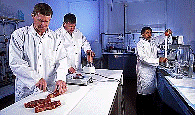United States Department of Agriculture: Agricultural Research Service, Lincoln, Nebraska

Roman L. Hruska U.S. Meat Animal Research Center: Reports
Date of this Version
6-10-2022
Document Type
Article
Citation
Lindholm-Perry, A.K.; Meyer, A.M.; Kern-Lunbery, R.J.; Cunningham-Hollinger, H.C.; Funk, T.H.; Keel, B.N. Genes Involved in Feed Efficiency Identified in a Meta-Analysis of Rumen Tissue from Two Populations of Beef Steers. Animals 2022, 12, 1514. https:// doi.org/10.3390/ani12121514
Abstract
In cattle, the rumen is an important site for the absorption of feed by-products released by bacterial fermentation, and variation in ruminal function plays a role in cattle feed efficiency. Studies evaluating gene expression in the rumen tissue have been performed prior to this. However, validating the expression of genes identified in additional cattle populations has been challenging. The purpose of this study was to perform a meta-analysis of the ruminal transcriptome of two unrelated populations of animals to identify genes that are involved in feed efficiency across populations. RNAseq data from animals with high and low residual feed intake (RFI) from a United States population of cattle (eight high and eight low RFI) and a Canadian population of cattle (nine high and nine low RFI) were analyzed for differences in gene expression. A total of 83 differentially expressed genes were identified. Some of these genes have been previously identified in other feed efficiency studies. These genes included ATP6AP1, BAG6, RHOG, and YPEL3. Differentially expressed genes involved in the Notch signaling pathway and in protein turnover were also identified. This study, combining two unrelated populations of cattle in a meta-analysis, produced several candidate genes for feed efficiency that may be more robust indicators of feed efficiency than those identified from single populations of animals.


Comments
open access